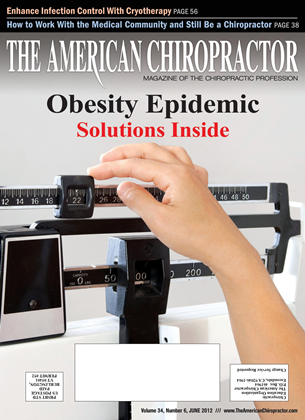Building a working relationship with the medical community is a wonderful wav to reach patients and create a referral nctw ork that will continue for the life of your practice. If done properly, chiropractic can stand as a separate and distinct treatment option. Many doctors erroneously think that you have to "change" chiropractic for us to be accepted into the medical community. In my personal experience nothing ^ could be further from the truth, but there are steps to be taken for the process of building the relationship properly. Understanding the barriers is the best way to start. The first major barrier to building medical relationships is your ability, as ridiculous as it may seem, to convey your diagnostic skills to the MD. The first family practice resident that I had in mv office for the chiro- practic elective at the State University of New York at Buffalo School of Medicine and Biomedical Sciences actually said. "I am surprised at the level of detail in your initial examination." Medical providers do not receive any exposure to chiropractic practice: therefore the default reasoning is chiropractic care is sub-par. While we know this to be untrue, it is the reality nonetheless. I have said it before and I" 11 keep saving it. the medical community docs not care at all about your technique. They refer based on tnist and clinical reputation. They need to be able to tnist that you will be able to take care of their patients. Can you and your office handle complex cases and manage patients in a collaborative environment? Does the medical community in your area know ? The next barrier to building medical relationships is continuing to display your clinical skills through reporting. Reporting is a critical part of building a relationship with health care providers. Without it you arc a NON-PLAYER, pure and simple. Your report is critical and many chiropractors have trouble understanding what to write and when to do a report. It is important that you touch the report only once, therefore your initial note should be in a format that can be used for insur- ancc reimbursement, compliance, reporting to the MD and. if necessary, reporting to the lawyer. The initial report and each re-evaluation should get sent via fax. To keep this streamlined my office staff will take the report that is printed from my EMR and fax it to each of the providers or professionals that arc CCd at the bottom. For example, the original would go into the patient's chart, a copy would be sent to the primary care physician, the medical specialist, the insurance carrier (this is sent with the billing automatically) and the lawyer. We didn't spend any money on stamps, the reports get there immediately and we have a delivery confirmation so we can prove they were received. That is extremely efficient and I should point out that I do not do a separate progress note and a letter to tnc ML), tne progress note IS the report. Touch it once and be done with it. Lastly, all this can be done without compromising who we arc and what we do. Our single biggest problem and the reason we only treat 8% of the population is we dont effectively report what we do. When we dont communicate effectively, all that we are left with are other providers" assumptions on what chiropractors arc thinking and doing. We rely on the patient going back to the MD and telling them what is wrong with them, and you know how accurate that can be! The language in our reports is critical to building relationships: we arc not "becoming" them any more than they are "becoming" us. There is a place for discussion of chiropractic principles, vertebral subluxation and who we arc as a profession. Please understand that none of those things can be discussed until the medical community that you want to work with trusts you as a doctor and clinician. That is how we win. Dr. Owens has established the nation s first chiropractic elective in a Family Residency Program with the SI/NY at Buffalo School of Medicine and Bio-medical Sciences. He has developed and credentials chiropractors to teach courses approved for C 'ME credit to the medical community. He can be reached at 716-228-3847.1 I have said it before and I'll keep saying it, the medical community does not care at all about your technique.
 View Full Issue
View Full Issue






